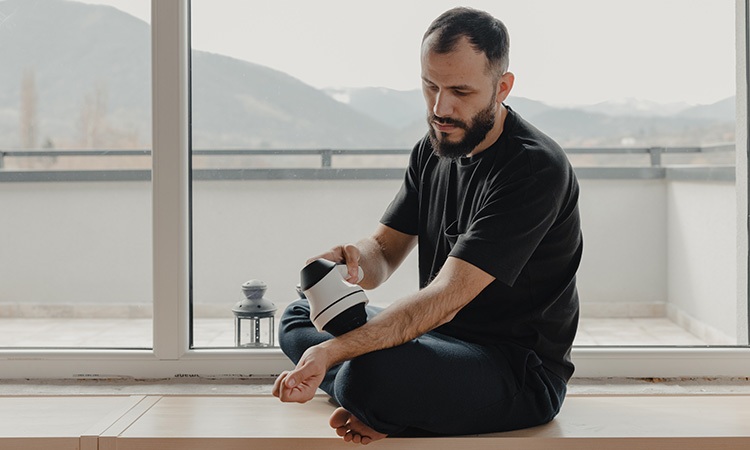Create a One-Stop Wellness Program

A wellness program promotes the health and fitness of an individual. As a massage therapist, you are in an excellent position to provide a large part of this wellness program to your clients. Once your client realizes all you can do for them, they will become a re-occurring appointment on your schedule for years to come.
By implementing a wellness program, you can begin to no longer worry about fluctuating appointments from week to week, and instead have a monthly income you can count on. Would you like to know how to become booked two to three weeks out? Read on and learn the power of assigning homework to clients.
Educate Clients
When a client meets you, they should understand you are there to improve their life. As a massage therapist, you have a unique toolset many other professionals do not share. You can accomplish a lot in a one-hour session, but your help does not stop there.
Never treat the time the client is on your table as the only time you can influence them. Your goal is to become integrated into their life to help them while they are away from your table too. You can do this by offering them tools and knowledge to help themselves until they return to see you. Think of yourself as a one-stop wellness program for their soft-tissue needs.
First, you must believe their massage time with you is essential. Remember, you are a wellness professional. Have confidence in your skills and your ability to have them leave your table in a better place than when they arrived. This could look like the client feeling less stressed or less pain. Identify your strengths and wholeheartedly know you can help the client every time they receive a massage from you.
Second, communicate the importance of having a regular appointment with you. Clients must understand their massage is important enough for a reoccurring appointment. Every client should be on a recurring schedule—anywhere from once a week to once a month.
Make it a goal to hit that reoccurring button on your scheduling software for every client. Make a spot for each client in your schedule. Let them know “their” spot is every other Tuesday at 10:00 a.m. Regular massage does a body good, and you will keep adding value to each session so your clients look forward to their return.
Each session builds upon the last and moves the client closer to their overall goal. This goal can be simple. It can be a sense of rejuvenation or well-being, decreased pain or increased range of motion. If you believe the client’s time with you is essential, they will also believe it.
Now let’s get to the part that will help solidify that client’s re-occurring appointment, which will solidify your income.
Assign Homework
Giving clients something to do at home shows them you care about what they do outside the treatment room. The time they are on your table is relatively minor compared to the time away from your table.
You should care about what they are doing between visits, and homework helps keep their wellness front of mind. Of course, you should perform due diligence to make sure anything you suggest to a client is within your scope of practice.
Assigning homework creates a partnership with the client and helps build your wellness program. The accountability is returned to them as they become partially responsible for their outcome. You are there to support them along their wellness journey, but you cannot do it for them.
This is where the tools and education you provide will give them the power to help themselves. The client can actively participate in their recovery or toward a healthier lifestyle. Clients may be pleasantly surprised with this approach and become excited to progress.
Types of homework you can provide to clients might include:
• The instruction to drink more water on a regular basis
• To stretch
• To practice self-massage
• To engage in hydrotherapy, such as a hot bath.
Hydrotherapy
Remember hydrotherapy as an option for homework for clients. If a client is seeking massage for pain, this is a natural homework assignment for them to complete at home. Recommend heat or ice on an area of the body. Give the client guidelines for how long to apply and if they are to alternate heat and ice or do one.
A hot bath is a simple form of hydrotherapy recommended for clients needing stress relief. Pair it with aromatherapy or salts, and you have a grateful client. Give that mom of three the homework of a quiet bath, and you’ve given her a wellness program she wants to continue.
“Drink More Water”
Do you greet each client with a cup of water after each massage? Drinking more water may sound like basics after a session. Some therapists say, “Be sure to drink more water today,” but I want you to take it one step further.
You can assign your client the homework of drinking more water daily, give them the reason, and then check in with them during their next appointment about how they did. It can sound something like this:
After the massage session, ask how the client is feeling. Specifically, ask about one concern they told you about during the intake that day.
“How is your low back feeling after you get off the table?”
You can let them know one thing you found during the massage. “It felt like the left was a bit tighter than the right.”
Give them a suggestion of homework to do until you see them next. “Do you drink much water?” (Listen to their answer and tailor your response.)
Inform them, “Muscles respond better to massage when they are well hydrated. We can reach your goals faster with this simple step.” “Drinking at least 72 ounces of water each day is recommended. I have a great handout I will send home with you.”
This handout can be a simple water tracker with checkboxes for each glass of water the client drinks. Or you could send some recipes for adding fruits and vegetables to flavor the water.
The homework step works best if the client walks out the door with something in their hand. So create a quick handout to send home with them.
The client becomes more engaged and intrigued by this assignment. You will ask how they did with their homework during their next session.
This homework also naturally leads to there being another appointment because you already alluded to the fact.
Offer Products for Sale—or Giveaways
Another homework possibility is selling the client a tool. Many massage therapists have a resale section of their business. It’s good customer service to offer items that are complementary to your massage. These items should have a purpose and help the client reach their goal while away from your office.
These items for sale could be things like handheld massagers (electric or not), trigger-point tools, body scrubs, topical analgesics or eye pillows, to name a few.
As the client’s session finishes, ask how they feel and take a moment to walk them over to the item you think would be suitable for their homework. If you’ve found they have stubborn upper traps, a massage tool used daily in that area will help them feel better. Show them where they should use it and tell them you will note the difference next time you see them. There. You’ve created a partnership and have a re-booking.
Consider your services to decide on the products you want to sell. What could you offer to complement your service while the client is at home? Some examples:
• An eye pillow for better sleep.
• Analgesic (spray, roller, rub-on) for aches.
• Massage tool for self-massage. Demonstrate how it works.
• Trigger-point release tool. Show the client where to use it.
• Sugar scrub for their feet and self-massage.
• Salts for a bath.
• Aromatherapy.
• Foam roller.
• Massage ball for plantar fasciitis.
Remember to obtain a resale license or permit if you decide to sell items to clients. Check your local area for requirements.
If you’d rather use giveaways, tennis balls for self-massage and small bags of Epsom salts are two good options.
Tennis balls are a great self-massage tool. If your client comes in complaining of neck pain, give them a ball after the session to lay under their occiput for self-massage.
Many areas of the body can be massaged with a tennis ball. The arch of the foot, calves, hamstrings, quads, glutes, and all areas of the back are a few possibilities for tennis ball self-massage. Forearm massage can be done with the arm lying on a table and the ball rolling over the top. Give your client a quick demonstration and send them out the door with homework and a smile.
Find a bag of lower-quality tennis balls so your price per giveaway is under one dollar. You aren’t going to give one to every client. Pick the clients you see who need a self-massage at home.
Another easy giveaway that doesn’t cost you much is salts for soaking sore muscles or relaxation. Give your client a cup of Epsom salt in a bag to soak in. This is easy homework and within a massage therapist’s scope of practice.
These are giveaways with a minor investment for your business and can be written off as a business expense for self-employed massage therapists.
Earn an Advanced Credential
Let’s talk about other forms of homework that complement your massage work. These may require you to get certifications beyond your massage license, depending on the state where you live. I recommend finding one of these you like and adding the credential to increase your customer service and massage skills.
Stretching
The natural progression after a massage is to have the client keep those muscles as supple as possible until the next time they see you. Stretching is an excellent way to accomplish that.
After a massage session, pick one or two stretches for the client to do at home and demonstrate them. If you are pressed for time before your next client, there are easy-to-show stretches that take 1-2 minutes. If you can create extra time between sessions, do so. This “teaching” time will significantly improve your retention rate with clients.
Another piece to make this homework successful for the client is to send home a handout showing a picture of the recommended stretch. This is a physical reminder of their homework and a visual guide to performing it correctly. If you want to avoid making your handouts, there are done-for-you options you can buy online.
Be sure to check your state board regulations to see if you can recommend stretches to clients under your massage license. If you live in a state where stretching is outside your scope of practice, consider pursuing credentials as a personal trainer, athletic trainer, or a certification as a stretch coach.
Nutrition Coach
Nutrition is part of a wellness plan and is an area where you can become certified. A healthy body includes proper nourishment as well as supple muscles. Look for nutrition programs that teach the basics of healthy eating so you can provide clients with general guidelines for their diet.
There will be a scope of practice surrounding this, as only registered dietitians can prescribe meal plans. But there are plenty of areas of eating a well-rounded diet you can become certified in speaking with clients about.
Personal Trainer
Chronic pain and acute injuries recover differently, but both benefit from strengthening. Knowledge of muscular movement and how to strengthen muscle groups would be an asset to your clients.
When a client comes to you with shortened pecs and scalenes, weak traps and rhomboids, and a rounded posture, you could offer homework like an exercise or two to compliment your massage work. If this interests you, seek training to become a certified personal trainer.
Put It All Together for a Client-Centered Wellness Program
The wellness plan you create for your clients can be nicely well-rounded. They will have a re-occurring appointment set with you. They have one or two items for self-care they’ve purchased for use at home between appointments. They can be reminded to drink more water periodically or turn their water-tracking chart back in to you for a new one as time passes.
When you get further credentialed, you can even offer clients more through stretches, exercises or nutrition tips.
With all of these areas combined, you, as a wellness professional, can offer more than a single massage. You can provide clients a comprehensive wellness program that supports their wellness goals—and your practice.

About the Author
Angela Lehman is a massage therapist of 25 years turned online educator, promoting fitness and nutrition for massage therapists. She runs The Fit MT. With her kinesiology degree specialized in nutrition, she trains therapists in healthy eating, exercise and body mechanics to prolong their careers. Search massagemag.com to read her The Fit MT column on topics including body mechanics, gut health and more.




